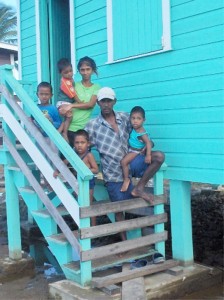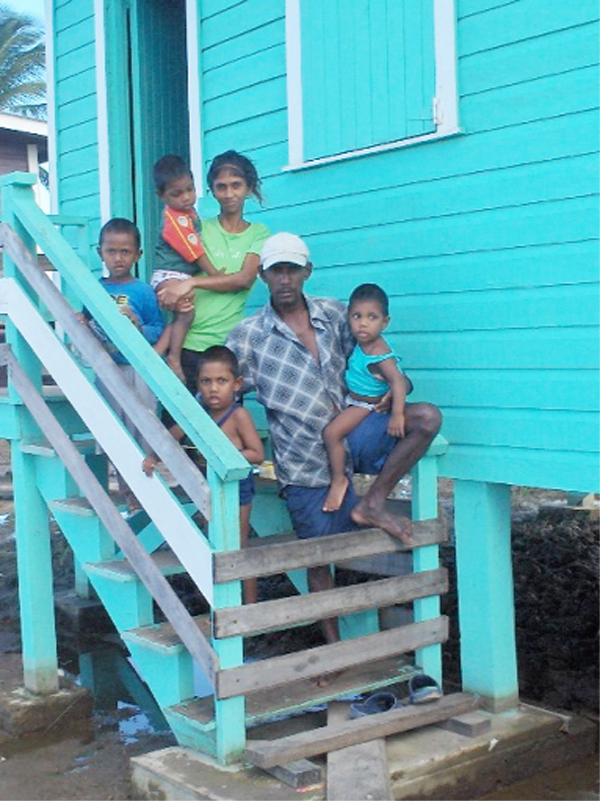Residents still wary
The drainage authorities have finally managed to free Dochfour residents of the inches of floodwaters which caused them misery for just over three weeks.

Floodwaters have also receded in many villages along the East Coast Demerara (ECD) following drier weather over the last two days.
When Stabroek News visited Dochfour shortly after 4.30 pm yesterday residents were in high spirits because, with the aid of two additional pumps deployed to the area by the National Drainage and Irrigation Authority (NDIA), the floodwaters had finally left the community.
Still many are fearful of what will happen since weather forecasts have promised heavy rainfall for some time yet.
“We glad de water gone…never mind is nuf nuf mud lef’ we can handle mud but we still nah know wa going to happen when de rest ah rain come,” one woman said.
Many expressed similar feelings but the fact remains that they have entered the New Year with much less that they had before. However, as one farmer put it, “we have strength and we are willing to work and build again”.
While the flood is gone fear still percolates through the community. Dochfour residents, while they are celebrating their “good luck”, still question who will compensate them for the livestock and cash crops they lost to the flood.
“One bag ah manure alone does cost we more than $10,000…they tell us to log down we losses and they going to see about compensating we,” a resident explained. “But to tell you de truth I ain’t sure we got anything to get from them.”
However, residents believe that the water’s receding had everything to do with the lack of rainfall and use of the pumps. They give no credit to the Hope koker for the water having left Dochfour. The koker’s failure in relieving the community of the floodwaters previously had been a chief concern among residents for weeks.
Stabroek News had learnt from Clement Corlette, Chairman of the Regional Democratic Council (RDC) of Region Four that the koker’s lack of performance lay in a faulty groyne which causes it to become easily silted. Corlette had reported that the Hope koker’s groyne was practically non-existent.
This, according to the RDC Chairman, was because the groyne is aged and needs to be maintained. However, while the National Drainage and Irrigation Authority had discussed the maintenance of the groyne, Corlette had explained that works would not start until later this year.
Although, residents have accepted that there is no other solution to the problem at this point but to ensure that the koker’s outfall is desilted as often as needed questions still remain to be answered. For instance, the Dochfour people question why it is that the Hope koker was only desilted around December 12 after the community was swamped in feet of water and not before and why it is only now that the RDC is admitting that the groyne has a fault?
Chief Executive Officer (CEO) of the NDIA, Lionel Wordsworth, had told this newspaper that prior to the December desilting the koker had last been cleared during the May/June period.
The Hope koker is also the main drainage source for Hope Estate, the Low Land Housing Scheme (located to the west of Hope Estate) and Nootenzuil. While most of the floodwaters have been drained from these communities it has also left behind the same frustration and hopelessness which the Dochfour people have brought with them into the New Year.
Hope Estate: A strange land away from home
Bumping along almost two miles of a road which is nothing more than a stone covered path with endless potholes leads to the section of Hope Estate which has been home to farmers originally of Joe Hook, Mahaica Creek for several months.
For many, Hope Estate is just a strange land away from home where they expected to find a bright future but only got a fraction of the flood-filled misery which had driven them from Joe Hook initially.
“Since meh get married this ah de first New Year meh spend like this,” Diamattie Ramotar said yesterday. “All meh life meh live ah Joe Hook and meh lef’ deh and come here and is de same thing,” the woman said looking at her Hope Estate yard which still had pockets of water.
Ramotar explained that staying in Joe Hook would have been better because she would have been in a place she knew well. “Never mind the water but at least I woulda been somewhere I know well, somewhere I know I belong,” she said.
The former Joe Hook residents occupy the first four streets in Hope Estate where they were relocated last May. The house lots were provided to them by the government in an effort to get them out of the oft-flooded Joe Hook area.
When this newspaper had visited the area during mid-December the estate was still under several inches of water. However, pockets of water and slushy mud were all that remained during our visit yesterday afternoon.
Mohanlall Doodnauth, a farmer who lives in the Second Street of Hope Estate, told this newspaper that it “hurt” him to leave his former home. Joe Hook, Doodnauth said, has always been his home; the place where he found his family and built his life; a place which holds his happiest memories.
“I lef’ Joe Hook so meh children could be safe because in de creek used to get over 6 feet water sometime…I lef’ so they could get to go school and it easier to get dem to a hospital cause it used to be trouble fuh get dem out of de creek,” Doodnauth explained.
According to the farmer, it was expensive and time consuming to get out of Mahaica Creek in times of emergency during the flood. Further, the man said that two years ago after Joe Hook had been greatly affected by flooding the government had promised him and the other farmers five acres of land each while they were discussing being relocated to Hope Estate. However, to date the man said they have gotten no land but have had to struggle to “scrape” whatever they could manage to support themselves.
“The flood wash away all we cash crop that we de planting here (Hope Estate) and now I got to look for whatever lil labour work I can find…jobs is hard to come by in this area,” Doodnauth said, nodding his head as if at a loss for further words.
Further, the man explained that had he been in Joe Hook now, despite the feet of water, he would’ve been able to locate some “high area” to do some farming. “In Hope Estate here all over got the same level so once you flood all over de place flood,” the man said.
Doodnauth and many others like him are constantly questioning their decisions to move to Hope Estate. They told this newspaper that they are no longer sure that the advantages they sought in moving to Hope Estate is worth disadvantages both physical and emotional that they have been going through.

